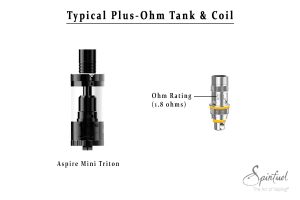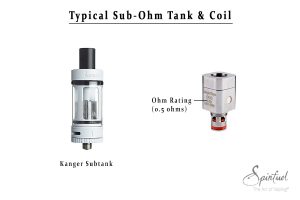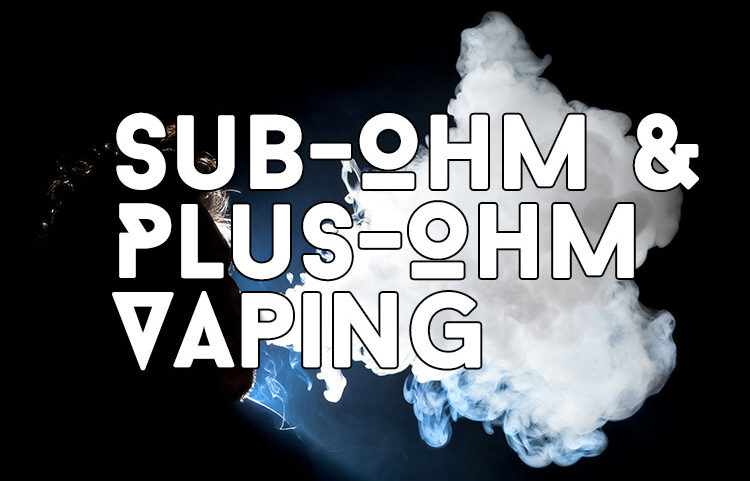Now you know the basics of vaping, it’s time to discover how it can work best for you. There are two main styles of vaping, both with varying benefits depending on what you want to get from it. These are sub-ohm and plus-ohm (sometimes described as regular ohm, sup ohm or high resistance).
They each work in very different ways and be tweaked for different results. In this section, we’ll tell you everything you need to know about these types of vaping to help you make an informed choice on what’s best for you. Some of the terminology might seem off-putting at first but don’t worry, we’ll explain things clearly and simply. If you have any questions, be sure to comment below!
What Exactly Are Plus-Ohm And Sub-Ohm Vaping?
With sub-ohm or regular ohm vaping, it all comes down to the kind of tank you’re using – or more specifically, the actual coil in the tank. Each coil comes with its own ohm rating, usually written on the side. Ohm is a unit of electrical resistance, and to put it simply if the coil is below 1 ohm it is sub ohm and if it’s above 1 ohm it is plus ohm. But how does this relate to vaping? Well, this simple difference has dramatically different effects. Let’s look at each in turn.
Plus-Ohm Vaping
 If a coil has high resistance, eg. if it’s 1.8ohms, this means it is resisting more power from the battery and will take longer to heat up and reach a certain point. In turn, this means your e-juice is vaporized at a lower rate compared to a sub ohm coil. This means batteries for plus-ohm vaping don’t have to give out as much power, and can be small and subtle.
If a coil has high resistance, eg. if it’s 1.8ohms, this means it is resisting more power from the battery and will take longer to heat up and reach a certain point. In turn, this means your e-juice is vaporized at a lower rate compared to a sub ohm coil. This means batteries for plus-ohm vaping don’t have to give out as much power, and can be small and subtle.
All Cig-A-Likes and early models of e-cigarette and vaping set-ups are plus-ohm, as the batteries were too small to power anything other than a high resistance coil. The lower heat means you inhale less vapor but it doesn’t necessarily mean the vape is substandard – indeed there are many benefits, such as improved flavor and a more intense throat hit. Regular-ohm vaping is most suited for a style of inhale known as Mouth To Lung (MTL).
MTL vaping works as you’d expect – you take a drag and keep the vapor in your mouth, then after a few seconds inhale it deep into your lungs along with extra air. If you’re a smoker, you’ll see that this is very similar to the way you take a puff on a cigarette. This is a key benefit of plus-ohm vaping, but there are many other advantages and disadvantages which we will look at in detail below.
Sub-Ohm Vaping
Sub-ohm coils have lower resistance meaning they heat e-liquid quicker and more powerfully. This makes for a dramatically different sensation from a regular ohm vape, with much more vapor production and a warmer and more substantial mouthfeel. This is a relatively new form of vaping and only became widespread over the past couple of years as vape technology became more advanced.
new form of vaping and only became widespread over the past couple of years as vape technology became more advanced.
Batteries need to be bigger to be able to produce more power meaning safety is a more pressing issue when using this kind of set-up. Sub-ohm vaping lends itself to the Direct Lung Inhale (DLI) style of draw.
DLI is when you take a drag and suck the vapor straight down into your lungs, similar to taking a deep hard intake of breath. If you’ve ever used a bong or shisha pipe, you’ll recognize this sensation. The hit from this can be much more intense than MTL and DLI fans claim it is much more satisfying. We will examine this, and other pros and cons of sub-ohm vaping below.
Pros And Cons Of Plus-Ohm Vaping
Pros:
More Flavor – The MTL style of inhale means the vapor is exposed to your tastebuds for longer, leading to an increased sensation of flavor. Also, ejuice designed for plus-ohm vaping carries flavor better, due to the increased amount of Propylene Glycol (PG) – we will look at this in more detail in the e-juice section of our beginner’s guide.
Most Like Smoking – Plus-ohm vaping allows for a higher level of nicotine, so can be useful for people making the switch from smoking. At the same time, the higher levels of PG and nicotine provide a satisfying throat hit, similar to that experienced when smoking tobacco.
Colder Vape – A hot vape can be unpleasant to inhale but the lower power level involved in regular ohm vaping makes for a reliably cool vape.
Drains Less Juice – The slower inhalation and lower battery means your eliquid lasts longer.
Subtle – A typical plus-ohm set-up is small and slim as the battery doesn’t need to be huge. And as they produce less vapor, they draw less attention.
Cons:
Weaker – As less vapor is produced, some users could find the sensation from a plus-ohm kit unsatisfying.
Out Of Style – Recent trends in vaping have been based around sub-ohm vaping, so there haven’t been many major innovations in regular ohm equipment in recent years.
Pros And Cons Of Sub-Ohm Vaping
Pros:
Fulfilling – Some smokers and ex-smokers prefer sub-ohm vaping as it gives a powerful hit, filling the lungs and making for a more satisfying and pleasurable sensation.
Clouds – If you’ve seen vapers blowing huge plumes of vapor and fancied it yourself, you need a sub ohm set-up.
Lasts Longer – Sub ohm coils, such as those used with the Smok TFV4, are usually quite large and sometimes contain multiple coils within them. This means they can last a long time, even weeks in some cases.
Cons:
Excessive – The amount of vapor produced can be overwhelming, and cause inexperienced users to cough. This can put newcomers off if they haven’t tried more subtle alternatives.
Drains Power And Juice – The more power your sub ohm tank requires, the quicker it will drain your battery. Make sure you have a backup. Similarly, these set-ups use up ejuice quickly as they’re heating more of it to produce large amounts of vapor.
Dry Hits – Dry hits are part of life for vapers. This is when you fail to see your tank is out of juice, so when you fire your mod it burns the cotton inside the coil rather than the e liquid. The resulting taste is very unpleasant, and if you do this on a sub ohm tank it can be many times harsher and more unpleasant.
Advanced Knowledge – To safely use a sub ohm set-up you need some basic awareness of battery safety. Batteries than can power a sub ohm tank need to be bigger and naturally more expensive than more elementary set-ups.
What Should You Choose?
When it comes to choosing the best set-up for you, it depends on a number of factors.
Experience Level – If you’re brand new to vaping, we recommend starting with a simple plus-ohm set-up, or even a Cig-A-Like. Then if vaping works for you, you can progress to a sub-ohm set-up later. We’ll look at this in more detail in the final part of our beginner’s guide, where we discuss our recommended vaping kits.
Allergies – Another factor is the ingredients used in your preferred type of e-juice. A small number of people are allergic to the PG used in plus-ohm e-liquid, and they require 100% VG juice, which can only be used in sub-ohm tanks. We examine the components of e-juice in more detail in the next section of this guide.
Type Of Juice – Some ejuice will only work in sub-ohm tanks, and some will work best in plus-ohm tanks. Juice that is high in VG will have trouble soaking the wick in plus-ohm coils, so if your favorite juice manufacturer only makes high VG eliquid, your only option is a sub-ohm tank. Certain flavors work best with each style of vape.
Tart tangy fruit flavors and tobacco are generally best in plus-ohm tanks, while thick, creamy and dessert-based flavors work best with sub-ohm.
Nicotine Level – Most sub-ohm juice comes with low levels of nicotine, usually 6mg and below, as taking a hit of anything higher can cause dizziness and nausea. Plus-ohm juice offers a greater range, meaning you have more control over your nicotine intake.
Clouds – Cloud-chasing and similar vaping tricks are a popular activity with many vapers, with worldwide competitions for who can blow the biggest clouds of vapor and perform the most impressive tricks. If this is a major attraction, you should choose sub-ohm vaping (preferably with zero nicotine!).
What Else Should I Be Aware Of?
Etiquette – While it can be very satisfying blowing huge clouds on a sub-ohm set-up, be aware of your surroundings and avoid doing it in public places. Many people frown on it, and it can damage the reputation of more considerate vapers.
Adaptable – There are ways of adjusting the type of vape, to make it more suited for different types of inhale. If you use a thin drip tip and a tight airhole, your sub-ohm vape can allow for MTL-style inhales and feel more like plus-ohm vaping. Similarly, if you choose a wide bore drip tip and wide open airholes on your plus-ohm tank, you’ll get an airy vape that can work for DLI. Vaping equipment is versatile and there are many ways of adjusting them to your personal tastes.
Consider Both – Many vaping enthusiasts don’t limit themselves to one style of vaping, and have both sub-ohm and plus-ohm tanks which they prefer to use at different times and in different places. Indeed some tanks, such as the Kanger Subtank and Aspire Triton, allow you to use both regular-ohm and sub-ohm coils for their tanks. This is a good option for people who would like to try out both style of vape, without buying two different tanks.
Conclusion
In this section we looked at the two main styles of vaping, and the advantages and disadvantages of each. While we recommend beginners try out plus-ohm vaping first before moving onto sub-ohm, if after reading this guide you prefer the sound of sub-ohm vaping over plus-ohm, we suggest you go to your local bricks & mortar vape shop first. Ask to test it out and get hands-on advice on how to use it safely.
Due to the increased cost and battery knowledge required to use a sub-ohm set-up we advise against purchasing this kind of gear outright as your introduction to vaping, but it’s worth trying both methods in time. Vaping is all about finding your personal preference, and it can be useful to try vaping at different ohm levels, until you find your sweet spot.
We’ll give a comprehensive guide to the best sub-ohm and plus-ohm vaping set-ups in a later part of this guide, but if you want to learn more about sub-ohm vaping, you can read our more advanced article here.


